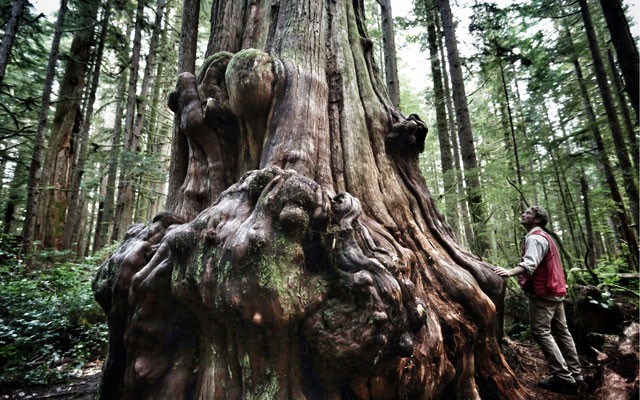When logging engineer and survivalist Grant Hadwin cut down the revered 300-year-old Golden Spruce (also known as Kiidk'yaas) on Haida Gwaii in 1997, he caused insult and injury to the Haida Nation and set off many questions.
Hadwin claimed to be protesting against the logging industry's extensive clear cutting on the archipelago, but before he could face trial he disappeared and remains missing to this day.
The mystery of Hadwin — the disappearance and his actions — led to a Governor General Award-winning book and now a documentary.
Hadwin's Judgement, by award-winning filmmaker Sasha Snow, is based on The Golden Spruce, the award-winning non-fiction book by Vancouver writer John Vaillant.
The co-producer of Hadwin's Judgement, Elizabeth Yake, says Snow's previous films and passion would make the film work as a docu-drama.
"The book was fantastic and in being able to tell the story, you'd worry about making a film that's inspired by the book. But Sasha is not retelling John Vaillant's story of the Golden Spruce. He's using it as the starting-off point and inspiration," Yake says.
Vaillant's book is in the tradition of fact-based storytelling, while Hadwin's Judgement is more about "the emotional through-line of the story and to make the film a bit more mythological."
Snow wanted to use the facts, Yake adds, but his main aim was to attempt to get inside Hadwin's head.
"It's quite interesting that Grant Hadwin didn't know very much about Haida Gwaii, clearly, because he didn't realize the significance of the Golden Spruce to the Haida people," Yake says.
"Nevertheless, I think he felt the magic of Haida Gwaii. I even felt it the first time I visited the islands with Sasha. It became really magical, the whole trip. It impacted the storytelling."
In an interview, Vaillant said he was going to talk about his book following the screening in Whistler.
"Sasha found his own way into the story," Vaillant says. "I will be doing a Q & A after the film."
He said that when he first heard the story of Hadwin and the Golden Spruce it took a while to understand what it was and its significance.
"I went up to Haida Gwaii in 2000 and I'd always wanted to go. I was on a paddling trip for a magazine," he says.
"I had an out-of-date tourist map with the Golden Spruce still marked on it, even though it had been down for three years. I went to look for the tree and one thing led to another. The tree's not there. Why not? Who did it? All those questions. It stayed with me."
Intrigued and disturbed he wrote a magazine article about the destruction of the tree for The New Yorker, the interest generated made him realize he had something more.
A genuine Canadian story, Vaillant said the international energy was marked.
"It was a market test on my part to see if there was enough interest to sustain and justify the effort that it takes to write a book," he says.
"Just to do the pitch took almost a year, the research so I could understand the story well enough... but it took a year to learn who Hadwin was, who his family were, how he fit into the scene in B.C.
"It was a really good pitch by the time I was done."
Hadwin remains missing, but Vaillant says there are still sightings.
"He's part of the coastal lore now. I just did a reading in Robert's Creek (on the Sunshine Coast) and one guy swore he was working with him as a roofer. I told him I didn't want to know... Frankly, I'm quite sure he died."
The screening and talk takes place at the Squamish Lil'wat Cultural Centre on Monday, March 14, at 6:30 p.m. Tickets are $18 plus GST and available at Eventbrite.
The event is presented by village book group Whistler Reads (www.bookbuffet.com), which is currently reading Vaillant's book The Jaguar's Children.
Vaillant's books will be available for purchase at the screening.




